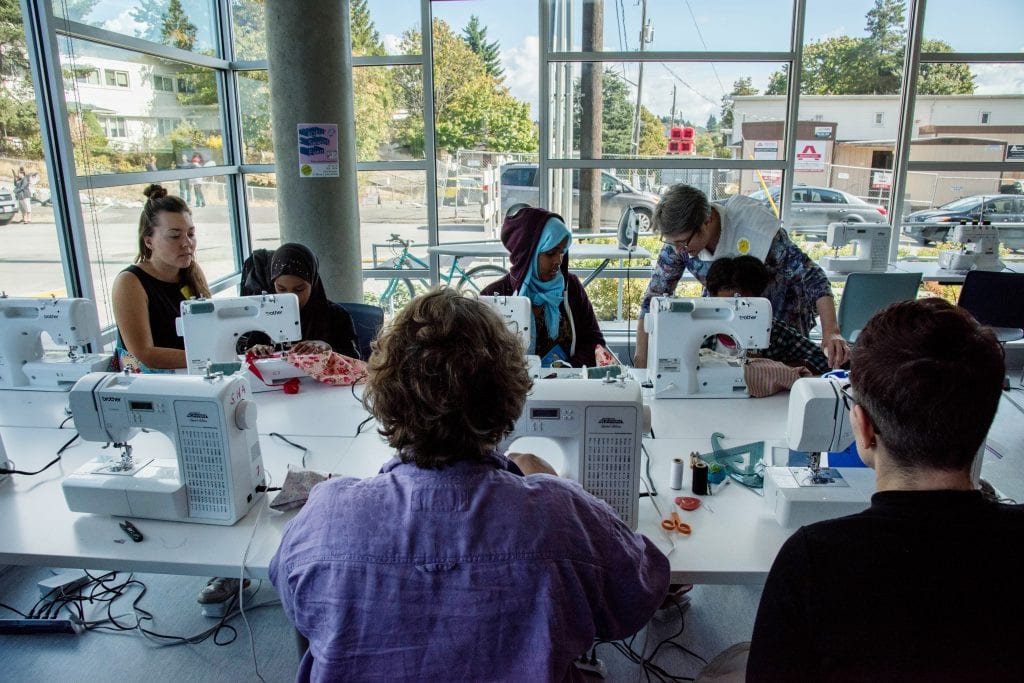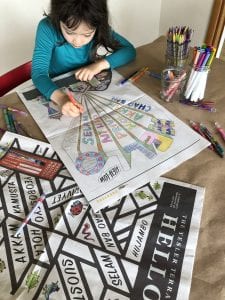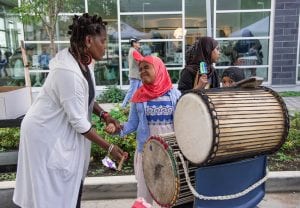
Yesler residents participate in a sewing workshop. Photo courtesy of Seattle Housing Authority
For many in the public housing realm, the arts and culture are nice-to-have amenities—a mural painted on a newly constructed building, perhaps, or a concert in a courtyard.
But at Yesler Terrace, a 30-acre public housing development near downtown Seattle, arts and culture play a more central role. Since 2015, the Seattle Housing Authority has worked to integrate arts and culture into Yesler’s ambitious redevelopment plan. Five years in, this approach has produced tangible benefits for the people served by the housing authority.
Yesler Terrace boasts a rich history, as well as a vibrant, diverse community. Completed in 1942 on a choice site with views of Mt. Rainier and Puget Sound, Yesler was Washington State’s first public housing and the nation’s first racially integrated public housing development. Jimi Hendrix is one of Yesler’s notable former residents.
But by 2006, it became clear that Yesler’s outdated infrastructure and 561 garden-style townhomes were beyond repair. So the housing authority began a conversation about Yesler’s future, engaging residents, city officials, key partners, and the citizens of Seattle. After intensive consultation and planning, the revitalization of Yesler Terrace got under way in 2013.
It’s a much-needed evolution. The new Yesler buildings—some already completed and occupied, others still under construction—will include 1,500 restricted-income units, tripling its stock of affordable housing in a city where such housing is disastrously scarce. Private developers are contributing a share of affordable units and will also add up to 3,000 market-rate units and 900,000 square feet of office space. The redeveloped Yesler will include new parks and open spaces, as well as a streetcar line that connects the development to the regional transportation system.
The desired result: a thriving, mixed-income community that honors Yesler’s history and culture while creating attractive, affordable new housing at a range of price points.
However necessary, the redevelopment is also disruptive and difficult for many. While all of Yesler’s original residents were given the option to live in the “new” Yesler, about half chose instead to move elsewhere. The community always had a core group of longtime residents for whom Yesler was “the destination,” and another group that was more in flux, for whom Yesler was more of a stop on the way to somewhere else. The redevelopment created a situation in which people had to decide which group they belonged to. At the same time, the influx of new residents and construction posed challenges for Yesler’s deep-rooted neighborhood spirit.
Enter Jennifer Song, administrator for arts and culture programs at Yesler. Hired in 2015 through a $678,000 grant from The Kresge Foundation, Song works with artists and residents to weave the threads of community and culture that make Yesler more than simply a place to live. Arts programs at Yesler have eased the challenges of redevelopment—including the decision to stay or go—by helping residents define what the community means to them.
A Common Space, A Shared Story
At Yesler, the arts are a kind of commons, a way to bring back what Song calls “the social overlay.” To maximize the community-building potential of the arts, Song hires artists-in-residence to develop community engagement programs. The artists become participating members of the community—attending neighborhood meetings and celebrations, partnering with staff and service providers on programs, and developing their own unique relationships with individuals and groups in the community over time.
Importantly, “[Song] brings in artists-in-residence who are not creating things but experiences,” says Stephanie Van Dyke, the housing authority’s former director of development. Rather than a prescribed set of activities and outcomes, artists-in-residence develop programs that respond to residents’ needs, concerns, and experiences in the redevelopment.
“Focusing on experiences allows us to prioritize process over product, which, at a very basic level, allows us to fail at things,” says Song. “We are constantly tuning our programs to resident feedback and community needs, which can mean that sometimes programs just don’t work out, or we need to make fast changes.”
Song engaged Rachel Kessler as an artist-in-residence to establish weekly and bi-weekly art clubs that meet in the buildings’ lobbies. Art clubs are drop-in programs, so anyone can join. The resources needed to support them are fairly minimal—the artist’s time and art materials. Projects and materials are kept modest for practical purposes, including ease of set up and cleanup in a building lobbies. Art clubs do, however, require an artist who is welcoming and flexible, and the full support and trust of property management staff who are responsible for the maintenance and management of building common areas.
The clubs serve a social as well as a cultural function: “Even if people come by for a minute, there is a little neighborly exchange,” says Kessler. Kessler’s art clubs have attracted repeat visitors, including seniors and youth, and have given her an opportunity to become a trusted presence in the community. In this way, the clubs are proving to be an effective strategy for defining how public or semi-public spaces can be owned and used by residents.

A young child uses crayons to color in an image on paper. Photo courtesy of Seattle Housing Authority
The art clubs have also had an impact beyond the Yesler community. Artworks created in the clubs were exhibited at the Seattle Art Museum in 2018. Exhibits like this may help shift broader perceptions and narratives around who lives in public housing.
Kessler also helped transform an unoccupied housing unit into a temporary community art gallery, meeting space, and art studio for residents. In addition to hosting cookouts and karaoke parties, the “art house” featured a resident-curated exhibit of memories from Yesler’s past, and visions for its future.
The exhibit helped residents celebrate and move on from Yesler’s past, says Sven Koehler, the housing authority’s relocation coordinator. “There was a sense of loss, of losing the yards, the personal space and the way the townhouses were,” Koehler says. The art house “gave people an outlet to express misgivings and the stress of moving…and helped people be more certain about where they were going,” he adds.
[Related: How Artists Helped a Housing Organization Adapt to Demographic Change]
The arts help the Yesler community define itself—its history and values. For example, longtime resident Charles Parrish was commissioned to create public art for the development; he elected to create a series of bronze medallions to celebrate people important to Yesler’s history. Self-taught artist Thanh Tran, who picked up painting to help cope with physical and mental health issues following a bad accident, was mentored by Yesler artist-in-residence DK Pan to create a building lobby installation focused on the hoa mai, a Vietnamese flower. Another artist, George Lee, created a sculpture modeled on the seed pods of the local Monterey cypress tree. Lee collected personal and historic keepsakes from Yesler staff and residents, which serve as a time capsule of this particular place in time.
Song also works to bring the arts into residents’ day-to-day lives. Before the pandemic, artist-in-residence Sumayya Diop led regular classes at Yesler: a dance-exercise class for elders, a movement and wellness class for young women, and a line-dancing workshop with Vietnamese seniors. Others led classes and programs such as a youth media program that trained Yesler teens to create mini-documentaries about their lives and community; and an art- and story-sharing program for mothers taking second-language English classes at the local elementary school. A popular sewing class—with childcare services—taught residents a craft that has practical and economic applications.
Arts and Culture for All
The benefits of these programs are easy to discern. For residents, they include greater access to the arts; strengthened networks in a community under transition; and an ownership stake in the place they call home.
At the most basic level, the programs democratize access to arts and culture by inviting participation from everyone. “Most people say, ‘I am not an artist,’” says Diop, “but everyone is an artist. They sing, they do spoken word, they play an instrument. We need to expand that whole idea about what art is. People look at the arts as a spectator, they come to watch. I want them to see that art lives in community, not just on the screen.”
And participating in the arts amplifies residents’ voices. “Low-income people and people of color are often asked and expected to be quiet, but the arts give you a platform for being seen and for being heard,” says Rachael Steward, the housing authority’s community services administrator. “The programming that’s happening [at Yesler] helps to affirm for existing residents that ‘yes, I have a place here. Yes, I am a contributor and my contribution can be in a creative space. And it can be something that I can belt out. I don’t have to be quiet about it.’”

Yesler artist explores drums with residents. Photo courtesy of Seattle Housing Authority
At Yesler, arts programming helps celebrate and sustain culture. Before the pandemic, a group of Ethiopian and Eritrean women met biweekly for a traditional coffee ceremony, preserving a beloved ritual from their East African homeland. Kessler helped the women in this group create personal family history albums, working with community leaders to manage the collection and sorting of photos, translations, and stories.
“Resident-led cultural activities like the coffee ceremony are critical to producing culture at Yesler,” says Song, adding: “In a period of community transition, these activities are even more essential, and it is the job of the arts programs to recognize and amplify their benefits. Resident voice and agency, cultural preservation, and celebration of people’s authentic traditions and narratives are all in play here.”
While helping to sustain residents’ cultures of origin, arts programs also unite residents across cultural divides and language barriers. “The arts bring people together,” says Van Dyke. “Dance is democratic; you don’t have to say much. Same with sewing and painting.” While ethnic groups tend to congregate together, partly because of their shared language, Diop saw those divides fall away at Yesler’s sewing classes. “Women from all different ethnic groups were interested in mending those clothes,” she says.
Benefits for Housing Staff Too
Arts and culture programs produce benefits for the housing authority’s staff, as well. For one, those programs create new channels of communication between residents and staff—a welcoming space to talk and relate. “Just by stepping in, and listening and hearing, they pick up on things that they can address today, before it becomes a passionate conversation,” says Ben Wheeler, the housing authority’s community builder. “The arts program provides gracious space for staff and residents to lay the groundwork for trust-building to flourish. Thanks to better communication, property management and residents actively partner together to address both concerns and interests. That builds a stronger sense of community,” Wheeler says.
Fitsum Abraha, Yesler’s senior property manager, sees the arts as a way to build a sense of belonging, so that neighbors answer to one another. “People participate in these clubs, and I think you create social accountability. They become accountable to each other without us doing anything,” he says. Abraha encourages team members to participate in cultural events, to improve relationships with residents: “Be among the residents,” he tells his staff. “That allows people to see you in a different light.” Recently, Abraha asked Song to provide arts-based training for his team, to enable them to get to know residents better.
The COVID Test
The value of Yesler’s arts and culture programming—for both residents and staff—has been put to the test during the COVID-19 pandemic. As elsewhere, the pandemic disrupted Yesler’s typical ways of planning, communicating, and gathering as a community. But Song found new ways to maintain a consistent presence at Yesler and respond to residents’ needs. “We had to rethink what’s useful in hard times,” she says. “And we didn’t want to put anyone at risk.”
Fortunately, Song’s programming was adaptable by design. Flexible contracts with artists dictated expectations, but not prescribed activities, allowing them to shift gears quickly. For example, when in-person, pre-pandemic means of communication were no longer possible, one artist produced a newsletter and activity guide that featured resident stories, artwork, and poetry. The newsletter included an insert with information and contact numbers for essential services relating to food and supplies, property maintenance, and COVID safety.
Arts programming aligned with emergency response efforts in other ways, as well. One artist collaborated with a Vietnamese community leader to create “cultural care packages” that included traditional food ingredients—such as fish sauce—that weren’t available in typical relief packages. And machines from canceled sewing classes were lent to Yesler residents, who were hired to make face masks for community members and staff.
Because the Yesler arts and culture program had built a solid base of trust within the community and among department staff, it was able to successfully pivot during the pandemic—making a positive contribution rather than draining resources. “We couldn’t have done that if we weren’t already deeply embedded in the community,” says Song.
Creative Placemaking Is Mission Critical
Song’s work at Yesler embodies “creative placemaking”—an approach that, according to The Kresge Foundation, “elevates arts, culture, and community-engaged design as central elements of community development and planning.”
“The need for creativity in community development, like the kind that the Seattle Housing Authority has been leading, is extremely important in places where there’s considerable income inequality and where fast-rising rents are causing increasing housing burden,” said Seth Beattie, senior program officer with Kresge’s Arts & Culture Program.
Kresge’s approach to Creative Placemaking combats the longtime pattern of low-income residents and residents of color frequently being left out of community planning and decision-making processes that affect their lives and neighborhoods, Beattie added.
“Not only did the Seattle Housing Authority take on one of the largest public housing redevelopments in the country, but the organization also simultaneously dedicated resources to fostering stability among residents living with low income through the Yesler Terrace Arts Initiative. SHA connected arts to greater economic and social inclusion for its tenants.”
For the Seattle Housing Authority, this approach has upended attitudes about the arts. “Watching the program has fundamentally changed my idea about what art can be in a community,” says Van Dyke. “I thought we’d get some nice art out of it, but this has been entirely different than I expected.” Song concurs: “We’ve seen incredible gains in [Seattle Housing Authority’s] understanding of why and how resident voice is essential to development practices,” she says.
At the same time, Song observes that creative placemaking efforts are about more than just engaging residents. “They’re about challenging the negative narratives that society puts on public housing authorities and their residents. They’re about helping people cope with past trauma and present anxieties and providing new opportunities for residents to actively determine what their community becomes. And they’re about breaking down the invisible lines between people who speak different languages, between the poor and the wealthy and between those who have called this home for decades and those who just arrived.”
Five years in, those efforts are firmly embedded in the housing authority’s work. Indeed, when the Kresge grant expired, the housing authority pooled internal funding with proceeds from land sales to continue funding Song’s position and the arts program. “Now it’s hard to imagine doing this kind of development work without the arts front and center,” says Van Dyke. “We’ve evolved in our understanding of how we can support this critically important work well into the future.”






Comments